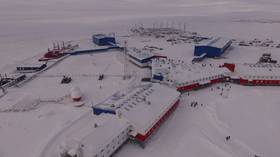Blooming in the Arctic: Russian military show off advanced Northern Clover base in DRONE OVERFLIGHT

The Russian military is upgrading its Arctic infrastructure, creating new bases and modernizing those already in place. A fresh video shows the technologically-advanced Northern Clover facility in Yakutia.
The base became operational in 2015 and is manned by 250 troops, supporting military operations on Kotelny Island, one of the New Siberian archipelagos off the northern coast of Russia. The facility also has the Temp military airfield and a high-power radar station capable of detecting any approaching threats from afar.
Northern Clover is the less-flashy cousin of the Arctic Trefoil, Russia’s northernmost base located some 1,900km (1180 miles) to the west on the Franz Josef Land archipelago. Both employ closed life-support system technology, allowing them to operate autonomously without a need for the troops to leave the buildings and expose themselves to harsh Arctic conditions.
Northern Clover can work autonomously for a year without any additional supplies. Notably, the complex also has a minimum effect on the Arctic’s fragile ecosystem and meets the highest standards of environmental safety.
The base is a symbol of Russia’s drive to protect its security and interests in the Arctic, which is increasingly attracting the attention of the world’s major powers. Last year, President Vladimir Putin said that Moscow had “reestablished itself firmly” in the Arctic, adding that the polar region is “extremely important” for Russia.
Russia’s Arctic shelf sea bottom contains vast oil and gas fields that become more and more accessible as the polar ice melts. Russia’s Northern Sea Route, which goes along the country’s northern shores, is also expected to see year-round cargo navigation and rapid growth of turnover in the future. That would cut transportation time in half compared to traditional routes through the Suez and Panama canals.
If you like this story, share it with a friend!














